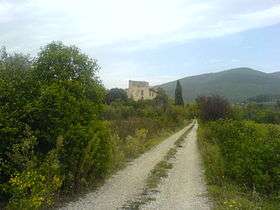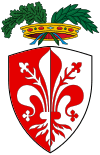Sesto Fiorentino
| Sesto Fiorentino | ||
|---|---|---|
| Comune | ||
| Comune di Sesto Fiorentino | ||
 Pieve of San Martino. | ||
| ||
 Sesto Fiorentino Location of Sesto Fiorentino in Italy | ||
| Coordinates: 43°50′N 11°12′E / 43.833°N 11.200°E | ||
| Country | Italy | |
| Region | Tuscany | |
| Metropolitan city | Florence (FI) | |
| Frazioni | Canonica, Cercina, Colonnata, Gualdo, La Zambra, Osmannoro, Padule, Querceto, Quinto Alto, Quinto Basso, Valiversi | |
| Government | ||
| • Mayor | Lorenzo Falchi (Italian Left) | |
| Area | ||
| • Total | 49 km2 (19 sq mi) | |
| Elevation | 55 m (180 ft) | |
| Population (1 January 2015[1]) | ||
| • Total | 48,946 | |
| • Density | 1,000/km2 (2,600/sq mi) | |
| Demonym(s) | Sestesi | |
| Time zone | UTC+1 (CET) | |
| • Summer (DST) | UTC+2 (CEST) | |
| Postal code | 50019 | |
| Dialing code | 055 | |
| Patron saint | Saint Martin of Tours | |
| Saint day | 11 November | |
| Website | Official website | |
Sesto Fiorentino (Italian pronunciation: [ˈsɛsto fjorenˈtiːno]), known locally as just Sesto, is a municipality (comune) in the Metropolitan City of Florence, Tuscany, central Italy.
History
The oldest known human settlement in the area dates from the Mesolithic (c. 9,000 years ago). The Etruscan presence is known from the 7th century BC, but the town proper was created by the Romans as Sextus ab urbe lapis ("Sixth mile from the Town Milestone"). The first churches were built in the early Middle Ages, among which the most important became the Pieve of San Martino. Sesto Fiorentino was subject to the Archbishop of Florence. Later it was under the Florentine Republic, which dried the plain and boosted the area's economy starting from the Renaissance age.
In 1735, Marquis Carlo Ginori founded one of the first porcelain plants in Europe, the Manifattura di Doccia. Now under the name Richard-Ginori, the company is still located in Sesto, and is the largest porcelain manufacturer in Italy. Toward the end of the 19th century, craftsmen who had been trained at Richard-Ginori began to start their own pottery studios, some of which also grew into factories. There are currently over one hundred producers of pottery in Sesto Fiorentino, and a state school for teaching pottery, now called L'Istituto Statale d'Arte.[2][3]
Sesto Fiorentino was annexed by plebiscite to the newly unified Kingdom of Italy in 1860. The town was a protagonist in the late 19th century workers struggle, and in 1897 it elected the second socialist member ever of the Italian Parliament, Giuseppe Pescetti. In 1899 it was the first town in Tuscany to have a socialist mayor.
Main sights

- Pieve di San Martino (Parish church of St. Martin), known from around the year 1000. The interior has a nave and two aisles, the inner part dating from the 12th century. On the high altar is a Crucifix by Agnolo Gaddi (1390); notable are also a Circumcision by Jacopo Vignali and a Four Saints by Santi di Tito.
- Palazzo Pretorio (1477).
- Santa Maria a Quinto, mentioned in the 11th century but rebuilt in the 18th century. It houses a notable triptych by Spinello Aretino and Annunciation from 1410.
- Villa Guicciardini Corsi Salviati
- Villa Paolina
- Villa Villoresi
- Park of Villa Gamba, known as Parco del Neto, an English-style garden built in 1853.
- Etruscan findings include the Tomba della Montagnola (7th century BC), the Tomba della Mula and the Necropolis of Palastreto (8th-6th centuries BC).
| Wikimedia Commons has media related to Sesto Fiorentino. |
International relations
Sesto Fiorentino is twinned with:
In literature
Sesto Fiorentino and its surroundings inspired the setting for the book The Adventures of Pinocchio.
Sherlock Holmes scholars determined that the unnamed Italian town in "The Adventure of the Empty House" was Sesto, and a bust of Holmes stands in the town.[6]
People
Poet Alberta Bigagli was born in Sesto Firorentino in 1928.[7]
References
- ↑ "Italian Population Statistics". istat.it. December 2009. Retrieved June 26, 2012.
- ↑ Ceramica Toscana.it, The ceramics tradition in Sesto Fiorentino Archived 2011-07-22 at the Wayback Machine.
- ↑ Ceramica Toscana.it, L'Istituto Statale d'Arte Archived 2009-04-17 at the Wayback Machine.
- ↑ "Wieliczka Miasta partnerskie" [Polish]. Urząd Miasta i Gminy Wieliczka. Retrieved 2013-06-25.
- ↑ www.arso.org
- ↑ "Sherlock Holmes Fans Play 'Great Game'". NPR. 2005-12-01. Retrieved 2015-11-06.
- ↑ "Alberta Bigagli". Casa editrice Tabula fati. Retrieved 2015-11-06.
External links
- Official website (in Italian)

